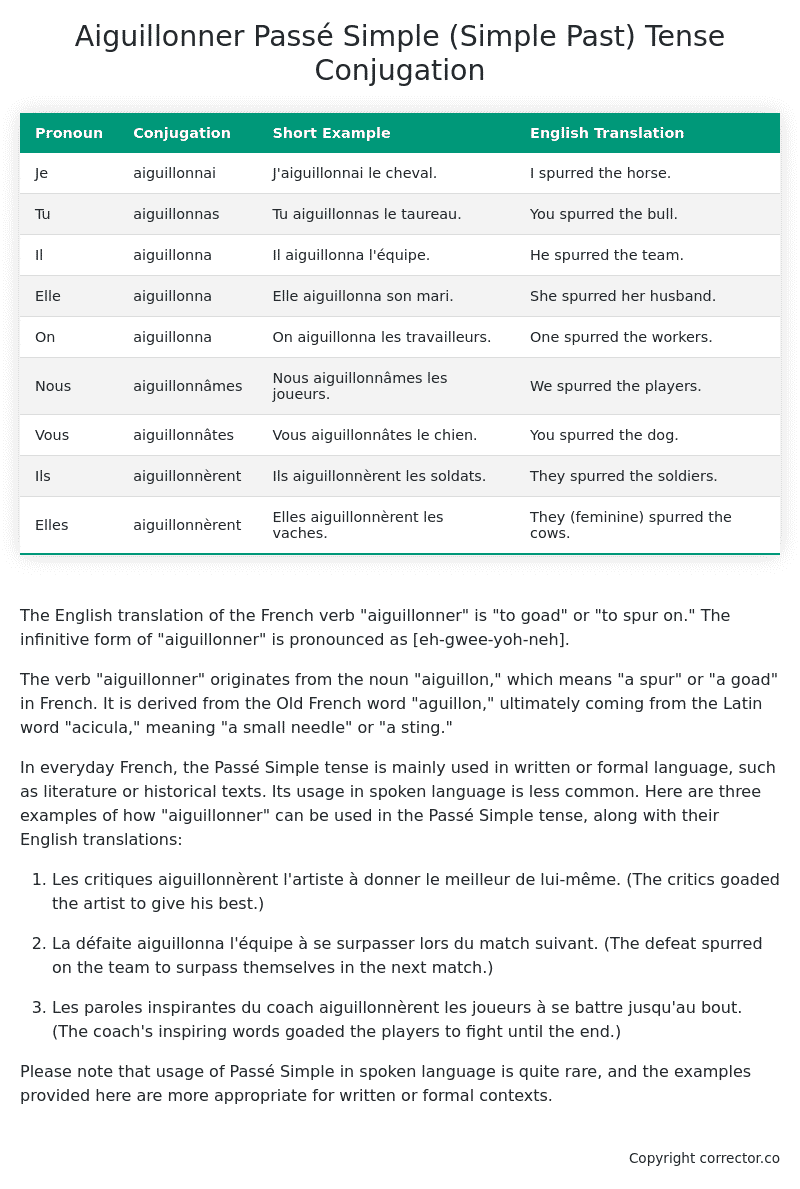Passé Simple (Simple Past) Tense Conjugation of the French Verb aiguillonner
Introduction to the verb aiguillonner
The English translation of the French verb “aiguillonner” is “to goad” or “to spur on.” The infinitive form of “aiguillonner” is pronounced as [eh-gwee-yoh-neh].
The verb “aiguillonner” originates from the noun “aiguillon,” which means “a spur” or “a goad” in French. It is derived from the Old French word “aguillon,” ultimately coming from the Latin word “acicula,” meaning “a small needle” or “a sting.”
In everyday French, the Passé Simple tense is mainly used in written or formal language, such as literature or historical texts. Its usage in spoken language is less common. Here are three examples of how “aiguillonner” can be used in the Passé Simple tense, along with their English translations:
-
Les critiques aiguillonnèrent l’artiste à donner le meilleur de lui-même.
(The critics goaded the artist to give his best.) -
La défaite aiguillonna l’équipe à se surpasser lors du match suivant.
(The defeat spurred on the team to surpass themselves in the next match.) -
Les paroles inspirantes du coach aiguillonnèrent les joueurs à se battre jusqu’au bout.
(The coach’s inspiring words goaded the players to fight until the end.)
Please note that usage of Passé Simple in spoken language is quite rare, and the examples provided here are more appropriate for written or formal contexts.
Table of the Passé Simple (Simple Past) Tense Conjugation of aiguillonner
| Pronoun | Conjugation | Short Example | English Translation |
|---|---|---|---|
| Je | aiguillonnai | J’aiguillonnai le cheval. | I spurred the horse. |
| Tu | aiguillonnas | Tu aiguillonnas le taureau. | You spurred the bull. |
| Il | aiguillonna | Il aiguillonna l’équipe. | He spurred the team. |
| Elle | aiguillonna | Elle aiguillonna son mari. | She spurred her husband. |
| On | aiguillonna | On aiguillonna les travailleurs. | One spurred the workers. |
| Nous | aiguillonnâmes | Nous aiguillonnâmes les joueurs. | We spurred the players. |
| Vous | aiguillonnâtes | Vous aiguillonnâtes le chien. | You spurred the dog. |
| Ils | aiguillonnèrent | Ils aiguillonnèrent les soldats. | They spurred the soldiers. |
| Elles | aiguillonnèrent | Elles aiguillonnèrent les vaches. | They (feminine) spurred the cows. |
Other Conjugations for Aiguillonner.
Le Present (Present Tense) Conjugation of the French Verb aiguillonner
Imparfait (Imperfect) Tense Conjugation of the French Verb aiguillonner
Passé Simple (Simple Past) Tense Conjugation of the French Verb aiguillonner (You’re reading it right now!)
Passé Composé (Present Perfect) Tense Conjugation of the French Verb aiguillonner
Futur Simple (Simple Future) Tense Conjugation of the French Verb aiguillonner
Futur Proche (Near Future) Tense Conjugation of the French Verb aiguillonner
Plus-que-parfait (Pluperfect) Tense Conjugation of the French Verb aiguillonner
Passé Antérieur (Past Anterior) Tense Conjugation of the French Verb aiguillonner
Futur Antérieur (Future Anterior) Tense Conjugation of the French Verb aiguillonner
Subjonctif Présent (Subjunctive Present) Tense Conjugation of the French Verb aiguillonner
Subjonctif Passé (Subjunctive Past) Tense Conjugation of the French Verb aiguillonner
Subjonctif Imparfait (Subjunctive Imperfect) Tense Conjugation of the French Verb aiguillonner
Conditionnel Présent (Conditional Present) Tense Conjugation of the French Verb aiguillonner
Conditionnel Passé (Conditional Past) Tense Conjugation of the French Verb aiguillonner
Conditionnel Passé II (Conditional Past II) Tense Conjugation of the French Verb aiguillonner
L’impératif Présent (Imperative Present) Tense Conjugation of the French Verb aiguillonner
L’impératif Passé (Imperative Past) Tense Conjugation of the French Verb aiguillonner
L’infinitif Présent (Infinitive Present) Tense Conjugation of the French Verb aiguillonner
L’infinitif Passé (Infinitive Past) Tense Conjugation of the French Verb aiguillonner
Le Participe Présent (Present Participle) Tense Conjugation of the French Verb aiguillonner
Le Participe Passé (Past Participle) Tense Conjugation of the French Verb aiguillonner
Struggling with French verbs or the language in general? Why not use our free French Grammar Checker – no registration required!
Get a FREE Download Study Sheet of this Conjugation 🔥
Simply right click the image below, click “save image” and get your free reference for the aiguillonner Passé Simple tense conjugation!

Aiguillonner – About the French Passé Simple (Simple Past) Tense
Formation
Usage
Narration
Historical Context
Interactions with other tenses
Passé Composé
Imparfait
Conditional and Subjunctive
Summary
I hope you enjoyed this article on the verb aiguillonner. Still in a learning mood? Check out another TOTALLY random French verb conjugation!


